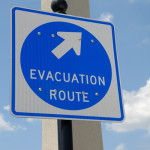Protect Your Vacant Property
Think an empty building doesn’t need maintenance or security? Think again. Unoccupied buildings tend to be more susceptible to damage and criminal activity than those filled with expensive equipment. If your property will be vacant, whether long or short term, you should secure it as soon as possible.
Main Risks For Empty Buildings
- Weather
We all know that weather can cause significant damage relatively quickly, especially for buildings in areas known for inclement weather. Damage to the exterior, including the roof and windows, can also make its way inside to cause further problems.
- Thieves
If you leave equipment or anything of value in an unsecured building, you run a high risk of theft. Even if you’ve emptied the property, thieves may still enter and steal valuable construction materials (ex. copper pines or wires).
- Vandals
Even though you may have cleared out your property, you are still at risk for vandalism. Vandals may trash your property by leaving waste, breaking things, and covering walls in graffiti.
- Trespassing
This covers a number of threats, which include squatting and illicit activities.
How To Secure Your Vacant Property
- Secure Entrances
Before vacating a property, be sure that all windows and doors are properly closed and locked. Look for gaps or damage to the frames that may allow wind, rain, or intruders to get in.
If you plan on leaving for an extended period of time, you should consider investing in stronger methods of securing doors and windows. While traditional wood boarding may be cost-effective, these have also added to the blaze of an arson attack. Investing in a metal alternative may be a better choice. You may also want to consider steel security doors which make it impossible to access your building without special equipment.
- Maintain Exteriors
Any loose objects can be stolen, used to gain entry, or used as a weapon. For example, bins, palettes and spare construction materials can quickly turn into projectiles in the wrong hands, or can be picked up by high winds in a storm. Be sure to store large objects indoors or out of sight.
Landscaping may be an afterthought, but can make a difference. You should keep pathways clear of debris, such as snow and ice in the winter, and trim grass and hedges to deter vermin from inhabiting your yard. Landscaping also makes it appear that the premise is occupied, making it less of a target.
- Check The Alarms
A security alarm is a necessity. A security alarm system can deter intruders, and, if linked to the local police, can elicit immediate response to any incidents. If you vacate your building, be sure to check your system regularly to ensure that it is functioning properly. If your system is managed by a third party, be sure to inform them of your absence.
Because a fire, whether intentional or accidental, is always possible, you should also maintain your fire alarm and sprinkler system. Be sure that pipes and sensors remain functional.
- Increase Passive Security
While dummy cameras can be a reasonable deterrent for those on a budget, operational security cameras may be a better investment. If you plan on leaving your property vacant for a longer period, you may want a real security camera to record any trespassers or criminal activity that occurs while you’re gone.
It may behoove you to make your property physically harder to access, especially if you have open spaces. Fencing and gates with proper locks and concrete barriers are effective ways to keep intruders out.
- Hire Active Security
If you will be storing valuable equipment and materials on site during your absence, you may want to hire professional guard control or even guard dogs and handlers. You can schedule the guard to check on your building at random times to keep trespassers away and to report any unusual activity.
If a building is scheduled for future renovation or demolition, registering your building for a guardianship scheme could be a more cost-effective solution. While you won’t be able to freely access your building when the guards are there, but it will safeguard against trespassers and squatters.
How do you protect your vacant property? Share your tips on Facebook, Google+, Twitter, LinkedIn, and Pinterest.
Find quality security cameras and CCTV surveillance systems when you shop at SecurityCamExpert.com! Visit us online or call 888-203-6294 to learn more about our services, including installation and support.
Connected Technology
Smart home technology – what once was a pipe dream is now coming to fruition. Technically referred to as home automation technology, it is comprised of computer devices that work together to manage various features in your home which would normally be controlled manually. Common examples include remotely controlling lights, thermostats, and even locking and unlocking doors.
As the demand for smart home technology continues to grow, it is important to understand how the technology works and develops to suit our growing needs and wants.
Internet of Things
Smart home technology thrives off of internet connectivity. More and more manufacturers are integrating Wi-Fi enabled remote controls into their products, enabling connection to your wireless home network and thus advancing the development of a “smart” network of appliances known as the Internet of Things (IoT).
Although more people refer to this as “smart technology” rather than IoT, the latter does address the very heart of the draw – the ability to control these devices remotely over the internet, no matter how far the distance.
Smart Security
One of the first places we saw widespread use of smart technologies was in home security systems by way of Internet-accessible security cameras. These security cameras allow homeowners to keep an eye on their property while they are away. As technology advanced, these became more compact and affordable, further spreading their use for home security.
Aside from cameras, more smart security devices emerged and included Wi-Fi enabled electronic deadbolts to remotely grant access to your home, smart lamps to control lighting to ensure you no longer enter a darkened home and smart thermostats to save energy and provide climate-control for a comfortable environment.
Entertainment & More
Security was not the only thing to benefit from IoT. Connected devices can now be found in the kitchen, with smart refrigerators that can remind you when you need to hit the grocery store and smart ovens that allow you to monitor your foods while they cook.
In terms of entertainment, web-enabled televisions can stream digital media content directly to the screen while being controlled by a mobile phone or tablet. Smart devices like Google Home or Amazon Echo can be given verbal commands to control nearly every aspect of your smart home.
As this technology continues to develop, what would you like to see? Share with us on Facebook, Google+, Twitter, LinkedIn, and Pinterest today!
Keep an eye on your home or business with our selection of quality CCTV security cameras and surveillance system packages. Visit us online or call 888-203-6294 to request a free quote or site survey today!
September Is National Preparedness Month
Recently, Hurricane Harvey and Hurricane Irma have devastated and affected many, leaving a trail of destruction in large areas. Whether it is hurricanes, thunderstorms or tornadoes, natural disasters provide a stark reminder of our vulnerability and that we should always be prepared.
September is National Preparedness Month and this year’s theme is “Disasters Don’t Plan Ahead. You Can.” Each week throughout the month focuses on a different theme, all helping to emphasize preparedness among everyone including youth, older adults, and people with disabilities and others with access and functional needs.
The best way to combat the unpredictability of natural disasters and emergencies is to plan ahead. Here are some helpful tips to help get you started.
Be Informed.
Visit www.ready.gov for more information on what to expect, how to make a disaster kit and how to prepare and plan ahead for disasters.
Many emergencies can happen anywhere, such as power outages or disease outbreaks. But certain disasters are more likely in some places than others. For example, in California, earthquakes are more common than tornados or tropical storms. Understand which types of natural disasters are common for your area and begin preparing for those accordingly.
It is recommended that you understand the local mass warning systems that officials will use to inform the public of extreme weather conditions. Commonly used are the National Weather Service and the U.S. Geological Survey. Know how to receive information from these agencies and prepare a backup way of receiving this information in case your primary system goes down.
You should also know where evacuation points are located in the event you cannot get home or your current location becomes unsafe. Know what circumstances would require evacuation and when to shelter in place.
Make A Plan.
Keep it practical and tailored to disasters you are most likely to encounter. Take what we have previously mentioned and discus it with your family. Go over different disaster scenarios and what the family plan is for each one. Things like whether it occurs on a weekday or weekend and if children are at school should all be considered while planning.
Making a disaster kit is the next step. You should include supplies necessary for a three-day period (the estimated time it might take to clear roads, restore power and have emergency crews reach people).
After a disaster, emergency responders will address critical needs first and might not be able to get to everyone right away. A disaster kit will allow you to take care of yourself, your family, and possibly others, freeing up emergency responders to focus on the critically injured and restoring infrastructure.
Creating multiple kits and storing them in different locations (car, office, home) is suggested – you never know where you will be when disaster strikes.
Get Involved.
You can participate in America’s PrepareAthon! – a nationwide campaign to increase community preparedness and resilience.
Share your own preparedness tips with us on Facebook, Google+, Twitter, LinkedIn, and Pinterest. Visit SecurityCamExpert.com to browse our stock of CCTV security cameras and systems to keep an eye on your properties.
Safety, Security, & Storage
Personal and public safety is always a top priority. Recent events have shown us that, whether planned or spontaneous, violent attacks can be extremely tragic and devastating. These also remind us that improving our security and surveillance systems is vital and show us what needs to be addressed and how we can safeguard against future threats.
Border & Airport Security
While border security is a controversial subject, in terms of security, the border or perimeter is essentially a vulnerable point of entry. Because of this, governments are looking to improve surveillance and secure boundaries. One way they are stepping up security is by employing remote video surveillance and analytics.
For example, the Department of Homeland Security have strategically placed towers to provide remote video surveillance along the southwestern and northern borders of the United States. The U.S. Customs and Border Patrol agency believe more towers would help to expand surveillance and provide more protection in remote areas.
Airports act in a similar fashion, as they represent a type of boundary and serve as a key point of entry for international travelers. With that said, airports must be monitored and secured carefully to protect not only passengers and visitors, but also aircraft, terminals, parking facilities, fuel facilities, airline buildings and power supply facilities. In addition, airports are often a prime target for terrorists since large, diverse crowds congregate, making security both critical and a major challenge.
Thus, video surveillance is crucial to airport security systems. Security cameras are placed throughout the various facilities to monitor crowd activity, perimeter gates and fencing, and other high traffic areas (ex. security checkpoints, baggage handling, hallways, seating areas, entrances/exits). Live streams are monitored continuously with the aid of video analytics and facial recognition is used for staff as well as guests. This technology quickly identifies who has authorized access to certain areas and can spot known suspects and criminals. Furthermore, virtual tripwires help to secure certain boundaries, and behavioral analytics algorithms help to detect any unusual behaviors, including left-behind packages.
To maintain optimal security and protection at borders and airports, security systems must monitor suspicious activity over time, track movements of watch-list suspects and share said information among agencies. It is a complicated process which depends on the sufficient work of real-time and archival video surveillance footage. And while advances in security camera technology (ex. higher-resolution capability, panoramic viewing, onboard analytics and integrated audio) are incredible, they also increase the need for sufficient storage capacity.
Before you make the decision on video surveillance storage, here are some factors to consider:
Retention Time
This can have a dramatic impact on the amount of storage necessary. Due to regulations and litigation issues, retention time is increasing, thus more storage capacity is necessary.
For example, HB 976 was passed in Georgia in 2016, requiring law enforcement to retain video from body-worn cameras and vehicle-mounted devices for a minimum of 180 days. In addition, any video recording related to a criminal investigation or pending litigation must be retained for 30 months.
Aside from complying with regulations, the value of video may increase in regards to analyzing people and patterns are observed over longer periods of time. It is important to consider long-term storage needs when making retention policy decisions.
Access
When it comes to storage, options include enterprise digital video recorders, boxed appliance network video recorders, PC-based network video recorders, enterprise storage platforms, tape, and cloud storage. Some make it easier than others to retrieve and share archived footage.
Before deciding on a storage solution, take into account the individuals who may need to access to the footage, how quickly they will need it and whether or not video files will be shared with other agencies.
Cost
Storage accounts for a good chunk of video surveillance budget since many opt for high-performance disks over tape (a more cost-effective solution). In order to minimize costs while still maintaining quality performance, you may want to size disk storage to meet ingest performance requirements, and then build long-term retention capacity using tape or cloud.
Video surveillance is a vital tool for law enforcement and other government officials, and the expanded use of more powerful cameras along with new video analytics greatly improves security. However, as mentioned, new capabilities have a significant impact on video storage as well.
Not all storage solutions are the same, thus, taking the time to understand how each solution works and finding a balance between retention time, accessibility, and cost is crucial to making the best decision.
If you need security camera systems and storage for your home or business, visit SecurityCamExpert.com to browse our stock. To schedule a site survey or request a free quote, please call 888-203-6294. You can also connect with us on Facebook, Google+, Twitter, LinkedIn, Pinterest, and Yelp!



